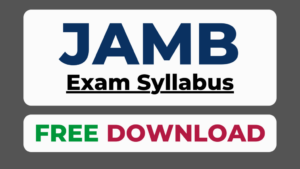JAMB Syllabus for Commerce PDF Download: The JAMB Commerce syllabus is designed to guide candidates preparing for the Unified Tertiary Matriculation Examination (UTME) in Commerce. This syllabus outlines key topics that cover both theoretical and practical aspects of commerce, helping students understand business operations, economic activities, trade, and related concepts.

JAMB Syllabus for Commerce Pdf Download
Here is a detailed breakdown of the topics in the JAMB Commerce syllabus:
Main Topics in the JAMB Commerce Syllabus
1. Introduction to Commerce
This section introduces the concept of commerce and its importance in economic activities.
- Meaning and Scope of Commerce
- Definition of commerce and its role in trade and industry
- Classification of commerce into trade and aids to trade
- Functions and importance of commerce in economic development
- Branches of Commerce
- Trade: Home (wholesale and retail) and foreign trade (import, export, and entrepôt)
- Aids to Trade: Transport, banking, insurance, warehousing, communication, advertising, and e-commerce
2. Business Units
This section focuses on different types of business organizations and their characteristics.
- Sole Proprietorship
- Characteristics, advantages, and disadvantages
- Sources of capital and challenges faced by sole proprietors
- Partnership
- Types, formation, rights, and responsibilities of partners
- Partnership deeds and dissolution
- Limited Liability Companies
- Features of private and public companies
- Formation, types of shares, shareholders, and management
- Differences between private and public limited companies
- Cooperatives
- Meaning and types (e.g., consumer, producer, marketing cooperatives)
- Principles and objectives of cooperative societies
- Public Enterprises
- Characteristics and examples (government-owned businesses, parastatals)
- Merits and demerits of public enterprises
3. Trade
This section discusses types of trade, their significance, and their role in economic development.
- Home Trade
- Types of retailers (e.g., itinerant traders, departmental stores, chain stores, supermarkets)
- Functions of wholesalers and their importance in the distribution chain
- Foreign Trade
- Types (import, export, entrepôt) and importance
- Documents used in foreign trade (bill of lading, consular invoice, letter of credit, etc.)
- Trade barriers and their impact on international trade
- Balance of Trade and Balance of Payments
- Definitions, differences, and how they affect national economies
- Components of the balance of payments (current account, capital account)
4. Aids to Trade
This section covers various services that facilitate trade and business activities.
- Banking
- Types of banks (commercial, central, merchant banks)
- Functions of banks, including lending, savings, and other financial services
- Role of central banks in controlling the economy
- Insurance
- Meaning, principles, and types of insurance (e.g., life, property, marine)
- Importance of insurance in commerce and trade
- Transportation
- Types of transport (road, rail, air, water) and their importance in trade
- Advantages and disadvantages of different modes of transport
- Warehousing
- Types of warehouses (public, private, bonded)
- Functions of warehouses in the storage and distribution of goods
- Communication
- Role of communication in trade and commerce
- Types of communication (postal, telephone, internet, courier services)
5. Business Finance
This section explores various sources of finance for business operations and capital needs.
- Sources of Business Finance
- Internal and external sources of finance (e.g., retained earnings, bank loans, trade credit)
- Short-term and long-term sources of capital
- Stock Exchange
- Functions and role of the stock exchange in business financing
- Meaning of shares, bonds, and debentures
- The role of the stockbroker in buying and selling securities
6. Business Environment
This section looks at the internal and external factors that affect business operations.
- Types of Business Environment
- Internal environment: Employees, management, company policies
- External environment: Political, economic, social, legal, and technological factors
- Government Regulations
- The role of government in business through taxation, subsidies, and regulations
- Impact of government policies on business activities
7. Business Law
This section focuses on the laws and regulations that govern business activities.
- Law of Contract
- Definition and essentials of a valid contract
- Types of contracts and their importance in business transactions
- Consumer Protection
- Consumer rights and responsibilities
- Agencies that protect consumers (e.g., Consumer Protection Council)
- Business and Labour Laws
- Laws related to employment, wages, working conditions
- Labour unions and their role in the business environment
8. Marketing
This section explores the principles and practices of marketing goods and services.
- Meaning and Functions of Marketing
- Definition of marketing and its importance in business
- Marketing mix (product, price, place, promotion)
- Advertising
- Role of advertising in promoting goods and services
- Types of advertising (print, electronic, online)
9. Entrepreneurship
This section focuses on the role of entrepreneurship in economic development.
- Meaning of Entrepreneurship
- Definition of entrepreneurship and its importance in job creation
- Characteristics of entrepreneurs and qualities needed for success
- Factors Affecting Entrepreneurship
- Government policies, access to finance, market conditions, and technology
- The impact of entrepreneurship on the economy
10. Consumerism
This section deals with consumer behavior and the protection of consumer rights.
- Consumer Rights and Responsibilities
- Definition and types of consumer rights
- Importance of consumer education
- Consumer Protection Agencies
- Roles of agencies such as the Consumer Protection Council, Standards Organization of Nigeria (SON)
11. Risk in Business
This section addresses the various risks businesses face and how to manage them.
- Types of Business Risks
- Financial, legal, operational, and market risks
- Strategies for managing risks (insurance, diversification, contingency planning)
- Importance of Risk Management
- Role of risk management in minimizing losses and maximizing profits
General Tips for Preparing for JAMB Commerce
- Understand Key Concepts: Focus on understanding the basic principles of commerce, including trade, business finance, and marketing.
- Practice Past Questions: Regularly practice with past JAMB questions to familiarize yourself with the exam pattern and question types.
- Study Business Laws: Pay attention to business laws, contract law, and consumer protection, as they are crucial for business operations.
- Master Aids to Trade: Learn the role and functions of aids to trade, including banking, insurance, transportation, and warehousing.
Recommended Textbooks for JAMB Commerce
- “Essential Commerce for Senior Secondary Schools” by O.A. Longe
- “Comprehensive Commerce” by J.U. Anyaele
- “Commerce for Senior Secondary Schools” by N.N. Oluwasegun
Jamb Syllabus FAQS
Is the JAMB syllabus different for UTME and Direct Entry?
The JAMB syllabus is primarily designed for UTME candidates. Direct Entry candidates may not need the syllabus as their admission process is based on their A-level or equivalent qualifications. However, some Direct Entry candidates may still find the syllabus useful if they are required to take certain exams.
How do I know if I’m using the correct JAMB syllabus?
Always download the syllabus from the official JAMB website or trusted educational platforms. Ensure the syllabus is for the correct exam year.
Can I combine the JAMB syllabus with past questions?
Yes, combining the JAMB syllabus with past questions is an excellent strategy. It helps you understand the exam pattern and practice questions based on the syllabus topics.
Can I pass JAMB without using the syllabus?
While it is possible to pass JAMB without the syllabus, using it significantly increases your chances of success. The syllabus ensures you cover all the necessary topics and avoid wasting time on irrelevant material.
Are there recommended textbooks in the JAMB syllabus?
Yes, the JAMB syllabus includes a list of recommended textbooks for each subject. These textbooks are aligned with the syllabus and are useful for in-depth preparation.
How can I use the JAMB syllabus effectively?
- Download the syllabus for your chosen subjects.
- Study the recommended textbooks and materials listed in the syllabus.
- Focus on the objectives and topics outlined for each subject.
- Practice past questions related to the syllabus topics
Does JAMB set questions outside the syllabus?
JAMB has stated that all UTME questions are based on the topics outlined in the syllabus. However, some questions may test candidates' critical thinking and application of knowledge.
How many subjects are in the JAMB syllabus?
The JAMB syllabus covers all the subjects offered in the UTME, including:
- Use of English (compulsory for all candidates).
- Science subjects (e.g., Physics, Chemistry, Biology, Mathematics).
- Arts and Social Science subjects (e.g., Literature, Government, Economics, Commerce).
- Other subjects like Agricultural Science, Geography, and Religious Studies.
Is the JAMB syllabus the same every year?
The JAMB syllabus is periodically reviewed and updated. However, changes are usually minimal. Candidates are advised to always check for the latest version of the syllabus for their exam year.
Where can I download the JAMB syllabus?
The JAMB syllabus is available for free on (jamb-portal). You can also find it on other educational websites or platforms that provide JAMB resources.
Why is the JAMB syllabus important?
- It helps candidates focus on relevant topics.
- It ensures candidates are well-prepared for the exam.
- It reduces the chances of studying irrelevant material.
What is the JAMB syllabus?
The JAMB syllabus is an official document that outlines the topics and subtopics candidates are expected to study for each subject in the Unified Tertiary Matriculation Examination (UTME). It serves as a guide to help candidates prepare effectively for the exam.
Conclusion
The JAMB Commerce syllabus covers a wide range of topics that help students understand the foundational principles of trade, business, and finance. By thoroughly studying the outlined topics, candidates can gain the knowledge necessary to excel in the Commerce section of the UTME.
